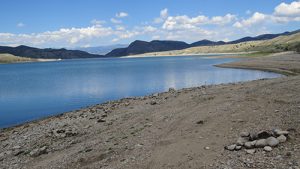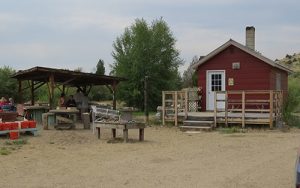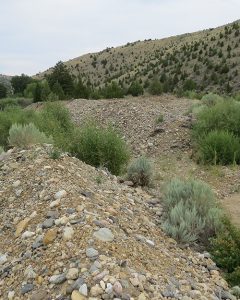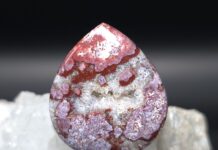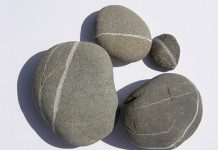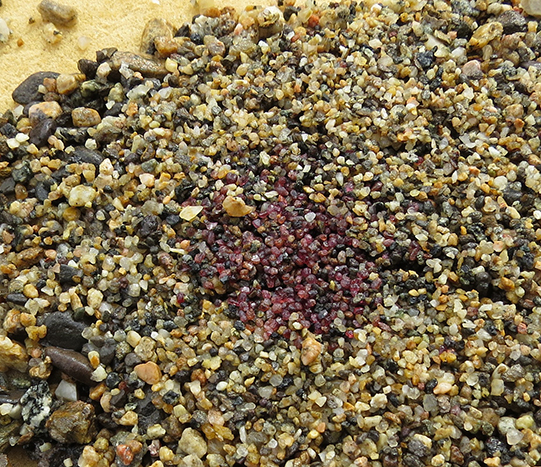
Story and Photos by Jim Landon
Imagine the earth 2.75 billion years ago in southwest Montana. If any life forms existed, they would have been microscopic. The atmosphere of our planet at that time would have been toxic, with little, if any, oxygen present, yet the geologic forces of mountain building and erosion would have been going gangbusters. Silt and sand would have been finding their way into the primordial oceans, and in turn these sediments would go on to be compressed into shale and sandstone. As time passed, these deposits would be deeply buried and subjected to the metamorphic processes of high temperatures and crushing pressure.
The sandstone layers were compressed and welded into quartzite and the shale deposits became slate, and then gneiss and schist. Minerals in the shale differentiated into mica, hornblende, and garnets. Limestone would be changed to marble and soapstone.
Understanding ‘Basement Rocks’
Still later tectonic forces bent and folded these metamorphic rocks like so much warm taffy, and faulting allowed the injection of hydrothermal solutions carrying silica, gold, and traces of copper and other minerals. Eventually, these tectonic forces would push these metamorphic layers, called “basement rocks”, toward the surface, and they would shed their mantle of younger rocks and sediment that had buried them so deeply.
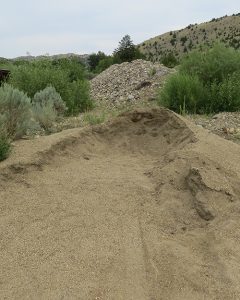
Uplift and subsequent erosion would exposed these rocks, and the gold and garnets they contained would start to concentrate in the streams that drained the area. By the mid-1800s, explorers and prospectors who had made their way into the Montana Territory would discover the wealth of gold the streams in this area contained, and a stampede of humanity would descend on the pristine valleys in pursuit of their fortunes.
One of these streams, Alder Creek, was found to contain gold in 1863. Initially, the deposits were mined by hand, using sluice boxes. This was supplemented in 1867 by the introduction of hydraulic mining, and in 1898 with the introduction of floating bucket dredges.
Heyday of Gold Prospecting in Alder Gulch
In the first three years of production, it is estimated that the miners in the 1800s had recovered around $30 million worth of gold. At today’s prices we are talking about over $2 billion worth of gold. This was indeed one of the richest—if not the richest—deposits of gold in the West. At the height of dredging there were five operations reworking the placer deposits. The thousands of people living in camps and small towns along the length of Alder Gulch had moved on to greener pastures or gotten out of the mining business. The dredge piles that resulted from years of mining and have yet to be reclaimed can be seen all the way from the town of Alder to Virginia City. It is as if Alder Creek has been turned upside down.
Although the miners and mining companies were searching for gold, their sluice boxes often filled with purple, water-worn almandine garnets. Since they had no value at the time, they were discarded in the tailings.
In the past 20 years or so, there has been increased commercial interest in recovering the garnets from these deposits for use as abrasives in water jet cutting technology and other applications. At first, alluvial garnets were being recovered from the old dredge piles, but it was found that production rates were not adequate to sustain the business. Now, open-pit mining is being conducted by the company Garnet USA to extract garnet crystals directly from the host schists.
Mined ore is being trucked four miles from the pit to a processing facility, where the ore is being crushed to free the garnet crystals. After further processing, the garnets are sorted by size to be sold to both national and international markets.
This brings us to the fun stuff: hunting for your own garnets in the Ruby Valley. I have visited three places where garnets can be found. One of these is along the banks of Ruby Reservoir, and the other two are tourist businesses where people can buy gravel and screen out the garnets.
Ruby Reservoir
Ruby Dam impounds water from the Ruby River, forming Ruby Reservoir. In the summer,
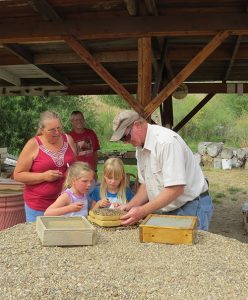
water that has been stored in the reservoir is released, exposing long stretches of beach where the sand, gravel and cobble deposits that contain alluvial garnets can be found. The garnets originated from schists exposed in the Greenhorn Mountains, which are located east of the Ruby River. The creeks flowing west from this mountain range transported the garnets into the Ruby River drainage and deposited them in high terraces that now form the banks of the reservoir.
Seasonal runoff and wave action from the reservoir continually expose and concentrate the garnets in bands along the shore. I visited this locality a year ago with my wife, Kerry, and friends Buzz and Patti Jones. We hunted on east bank of the reservoir, which we accessed by a road that can be found on the upstream end of the impoundment. To get there, we took state Route 287 to the town of Alder, then got on [state Route 357 (Upper Ruby Road)] going south. We passed Ruby Dam and then drove to the far end of the reservoir, where there is gravel and then dirt road that leads down to the lakeshore.
The high-water mark of the lake is heavily overgrown with willows, but there is ready access. After parking, we headed down to the shore and started walking the beach, looking for garnets among the cobbles that form bands where wave erosion has removed the lighter silt and sand. We found that the garnets were not evenly distributed along the entire beach, but rather occurred in hot spot concentrations that could be several yards long. It seemed that areas that had a clayey hardpan under the cobbles and gravel held the greatest concentrations of garnets. Most of the garnets we found were small, but occasionally one would show up that had faceting potential.
The best time to visit this locality is later in the summer, after the water level in the reservoir starts dropping, exposing more of the beach. I had brought along some screens that I had used to concentrate sapphires and garnets from other localities, but found them to be impractical at this locality. It was much easier and more productive to just find a hot spot and push the gravel and sand around with a stick to expose garnets that were large enough to collect.
Red Rock Mine and Garnet Gallery
The other two collecting spots that are designed for tourists are between the towns of Alder and Virginia City, along Route 287, which parallels the Alder Creek drainage. Dredge spoil piles dominate the landscape along the road. The first stop is called the Red Rock Mine and Garnet Gallery, on the left side of Route 287. This business sells 3-gallon buckets of material that has been recovered from the old dredge piles.
On the day we were there, Kerry and I were returning to our cabin from a day in Virginia City with friends Mike and Linda Sorensen and two of their granddaughters. I purchased a bucket of garnet-bearing material for each of the girls, and Steven Cox, the manager, showed them how to concentrate the garnets in the bottom of each of their screens. They had a blast picking through each screen full of material and picking out the garnets they had found. Steven drove me over to the place where he is getting the material for screening so I could get some photos of what the area looked like.
When the bucket dredges were active in Alder Gulch, they would scoop up sediment from the creek bed and run it through a rotary trommel to remove all the rocks, boulders, and larger gravel. This material was then carried to a stacker that would dump it in piles that form the characteristic windrows seen all up and down the valley today.
All of the finer material, which contained the gold and garnets, would pass over the sluice boxes, which were coated with mercury. The gold would stick to the mercury, and the garnets, gravel and sand would then be dumped off the side of the dredge. What this did was to create a two-layer profile in the riverbed, with the fines being covered with the rock and boulder windrows.
One-Stop Garnet Shopping
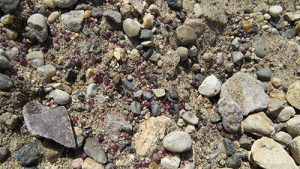
Steven had the rocks and boulders scraped off an area so that he could get in there with a trackhoe and access the sand layer that contains the garnets. He has stockpiled this material off to the side, and when he needs to replenish his buckets, he just drives over and loads them up. When we were there, he was charging $20 per 3-gallon bucket. He provided screens, tweezers to pick out the garnets, and a place to wash and concentrate the garnets. I call it one-stop shopping.
For those who like to do their own work, he also has a gravel pit where you can dig your own material to haul back to the sorting tables. He charges a flat half- or full-day fee for this opportunity, and there is no limit on the number of buckets you can process. Like at Ruby Reservoir, the vast majority of the garnets we recovered were small, but there were a few that might be considered faceting material.
Steven had some examples of stones recovered from the gravels that had been faceted, which were quite nice. Besides the garnets, corundum crystals are occasionally found on the dredge piles and in the garnet-bearing gravel. The ones I have seen are very silky and only suited for making cabochons or being kept for specimens.
The Red Rock Mine and Garnet Gallery is open Wednesday through Sunday from May 1 to Nov. 1, weather permitting. If you are interested in checking out this venue, I would recommend calling ahead to check on the status of the place. You can reach Steven at (406) 842-5760.
River of Gold
The second fee area is farther up the highway on the right, past Nevada City. It is called River of Gold and it features an opportunity to pan for garnets and gold, and has a number of mining-related artifacts that were salvaged and put on display. You can’t miss this place because the main artifact is the bucket dredge called the Mount Vernon. This behemoth piece of mining equipment was one of the five that processed the gravels of Alder Gulch for gold. All of the rest have long since been salvaged for scrap. It now sits on its sunken barge in what remains of the self-made pond where it ceased production. Looking at it up close reminded me of the TV show “Gold Rush”, in which Tony Beets has resurrected an even larger dredge to ply the gravels of the Klondike.
I had a great time walking around the dredge and checking it out from all angles. I was especially impressed with the bucket arm and the cast iron buckets that had wrested so much gold from the creek bed. They had to be made tough to be able to do battle with the compacted boulders, cobbles and gravel and not be destroyed. What an amazing and efficient piece of technology these things were.
At River of Gold, people can purchase gravel by the scoop and then use gold pans to concentrate the garnets and occasional piece of placer gold. There is also a shop where you can purchase [gold palling equipment].
Besides these places to collect garnets, the towns of Virginia City and Nevada City are great to visit. Nevada City has a gold mining-era town that features late-1800s and turn-of-the-century buildings that were salvaged from all up and down Alder Gulch and are now preserved for all to see. The Virginia City Preservation Alliance has worked diligently to preserve most of the buildings that were initially constructed in the 1870s. Many of them display period furnishings and have informational signs that tell the history of their use. There is also a narrow-gauge railroad that transports visitors between the two towns.
Turning to Tourism
Gold mining continues in the upper reaches of Alder Gulch to this day, in scattered, small
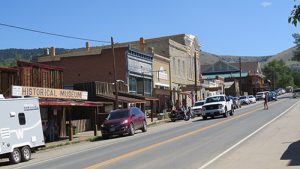
lode mines that lie hidden away in the pine- and fir-covered mountains above Virginia City. Miners are tapping the quartz veins that supplied the alluvial gold that started the rush so long ago. This activity is a mere whisper of what it was in its heyday.
Now, tourism is the main economic driver for the area. The population swells dramatically in the summer, with seasonal help working in the many shops and venues that are now housed in the period buildings. With the onset of fall and colder weather, the tourist populations dry up and most of the seasonal help moves on to other jobs, while the full-time residents start to hunker down for the long, cold winters that are common at this altitude.
It is not unlike what happened back in the boom and bust days of the gold rush that established these towns in the first place.


